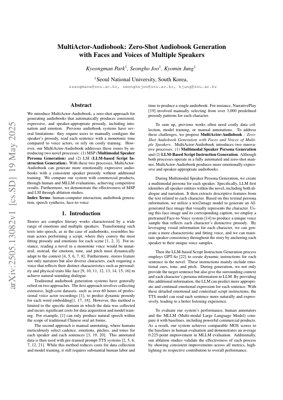Table of Contents
- 1. Introduction
- 2. Methodology
- 3. Technical Details
- 4. Experiments and Results
- 5. Future Applications
- 6. References
- 7. Expert Analysis
1. Introduction
Audiobook generation faces challenges in producing expressive, context-aware prosody and maintaining speaker consistency without costly data collection or manual annotation. Traditional methods rely on extensive datasets or human intervention, limiting scalability and efficiency. MultiActor-Audiobook addresses these issues through a zero-shot approach that automates speaker persona creation and dynamic script instruction generation.
2. Methodology
2.1 Multimodal Speaker Persona Generation
This process generates unique speaker personas by combining textual descriptions, AI-generated face images, and voice samples. An LLM identifies speaker entities and extracts descriptive features. A text-to-image model (e.g., DALL·E) creates visual representations, and a pretrained Face-to-Voice system (e.g., [14]) produces voice samples. The persona embedding $P_c$ for character $c$ is derived as: $P_c = \text{Voice}(\text{Image}(\text{LLM}(\text{Text}_c)))$.
2.2 LLM-based Script Instruction Generation
GPT-4o generates dynamic instructions for each sentence, including emotion, tone, and pitch cues. The input includes the target sentence, surrounding context, and character personas. The instruction $I_s$ for sentence $s$ is: $I_s = \text{GPT-4o}(s, \text{context}, P_c)$.
3. Technical Details
3.1 Mathematical Formulation
The overall audiobook generation process is formalized as: $A = \text{TTS}(\text{concat}(s, I_s), P_c)$, where TTS is a prompt-based text-to-speech system, $s$ is the sentence, $I_s$ is the instruction, and $P_c$ is the speaker persona. The persona consistency loss $L_c$ ensures voice stability: $L_c = \sum_{t=1}^T \| V_c(t) - V_c(t-1) \|^2$, where $V_c(t)$ is the voice embedding at time $t$.
3.2 Code Implementation
# Pseudocode for MultiActor-Audiobook
def generate_audiobook(novel_text):
speakers = llm_identify_speakers(novel_text)
personas = {}
for speaker in speakers:
text_desc = llm_extract_features(speaker, novel_text)
face_image = text2image(text_desc)
voice_sample = face_to_voice(face_image, text_desc)
personas[speaker] = voice_sample
sentences = split_into_sentences(novel_text)
audiobook = []
for i, sentence in enumerate(sentences):
context = get_context(sentences, i)
instruction = gpt4o_generate(sentence, context, personas)
audio = tts_synthesize(sentence, instruction, personas[speaker])
audiobook.append(audio)
return concatenate(audiobook)4. Experiments and Results
4.1 Human Evaluation
Human evaluators rated MultiActor-Audiobook against commercial systems on expressiveness, speaker consistency, and naturalness. On a 5-point scale, it achieved 4.2 for expressiveness and 4.0 for consistency, outperforming baseline systems (e.g., 3.5 for expressiveness in NarrativePlay).
4.2 MLLM Evaluation
Multimodal large language models (MLLMs) assessed audio quality, giving MultiActor-Audiobook a score of 85/100 for emotional appropriateness, compared to 70/100 for traditional TTS systems. Ablation studies confirmed that both MSP and LSI are critical for performance.
5. Future Applications
Potential applications include interactive storytelling, educational content, and virtual assistants. Future work could integrate real-time adaptation, support for more languages, and enhanced emotion modeling using techniques like CycleGAN for style transfer [23].
6. References
- Y. Ren et al., "FastSpeech 2: Fast and High-Quality End-to-End Text to Speech," in Proc. ICLR, 2021.
- OpenAI, "GPT-4 Technical Report," 2023.
- Zhu et al., "Unpaired Image-to-Image Translation using Cycle-Consistent Adversarial Networks," in Proc. ICCV, 2017.
7. Expert Analysis
一针见血: MultiActor-Audiobook isn't just another TTS paper—it's a strategic end-run around the data scarcity problem that has plagued expressive speech synthesis for years. By leveraging multimodal personas and LLM-based instructions, they've effectively outsourced the "understanding" of narrative context to general-purpose models, sidestepping the need for domain-specific training data. This is a classic example of the "foundation model as feature extractor" paradigm that's becoming increasingly dominant in AI research, similar to how CycleGAN [23] revolutionized unpaired image translation by cleverly using cycle-consistency losses instead of paired data.
逻辑链条: The core innovation here is a beautifully simple causal chain: text descriptions → visual personas → voice embeddings → consistent characterization. This creates what I'd call "emergent prosody"—the system doesn't explicitly model prosody in the traditional signal processing sense, but rather induces it through the combination of persona consistency and contextual instructions. The mathematical formulation $A = \text{TTS}(\text{concat}(s, I_s), P_c)$ elegantly captures how they've decomposed the problem into manageable sub-tasks, much like how modern neural rendering separates geometry from appearance.
亮点与槽点: The zero-shot capability is genuinely impressive—being able to generate characteristic voices from textual descriptions alone could democratize audiobook production. The use of face-to-voice systems as a proxy for personality embedding is particularly clever, building on established cognitive science about voice-face correspondence. However, the elephant in the room is computational cost: running GPT-4o per sentence for long-form content isn't cheap, and the dependency on multiple proprietary APIs (OpenAI for instructions, potentially commercial TTS systems) makes this less accessible for open research. The paper also glosses over how well the face-to-voice mapping works for non-human or fantastical characters—can it really generate convincing dragon voices from dragon images?
行动启示: For practitioners, this signals that the future of expressive TTS lies in compositionality rather than monolithic models. The winning strategy will be to develop robust persona embedding systems that can work with multiple backbone TTS engines. Researchers should focus on making the instruction generation more efficient—perhaps through distilled models or cache-based approaches. Content creators should prepare for a near future where generating professional-quality character voices requires nothing more than descriptive text. This approach could extend beyond audiobooks to gaming, virtual reality, and personalized education, much like how GANs spawned entire industries after their initial publication.
